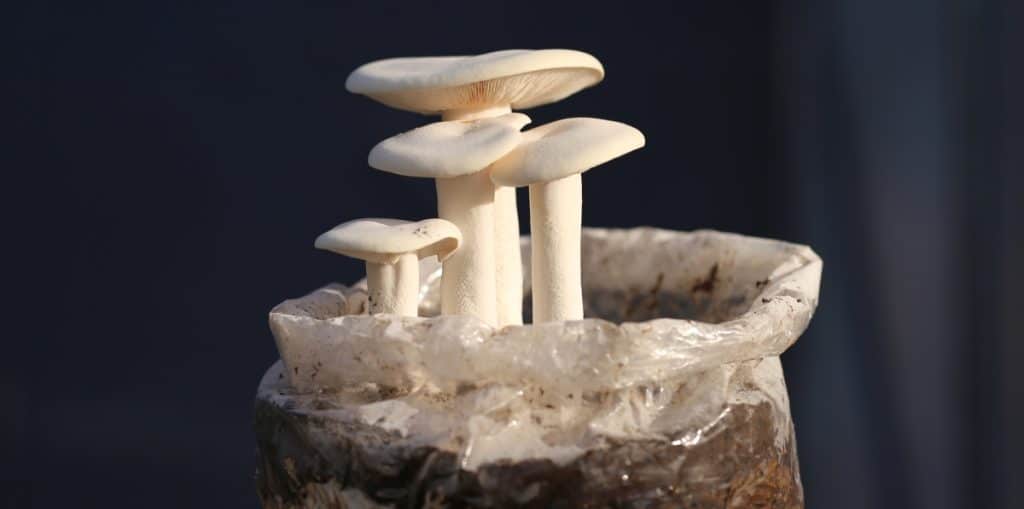If you’re a new mushroom farmer, one of the many decisions you’ll make is what type of containers to use to grow mushrooms.
The type of mushrooms you plan on growing, will dictate the substrate and conditions required and the best types of containers to use.
Although there are often several options, you can’t beat mushroom growing bags for ease of use, and they’re suitable for most mushroom species.
Read on to learn more about mushroom growing bags, their benefits, different types of mushroom grow bags and what to look for when choosing a mushroom growing bag.
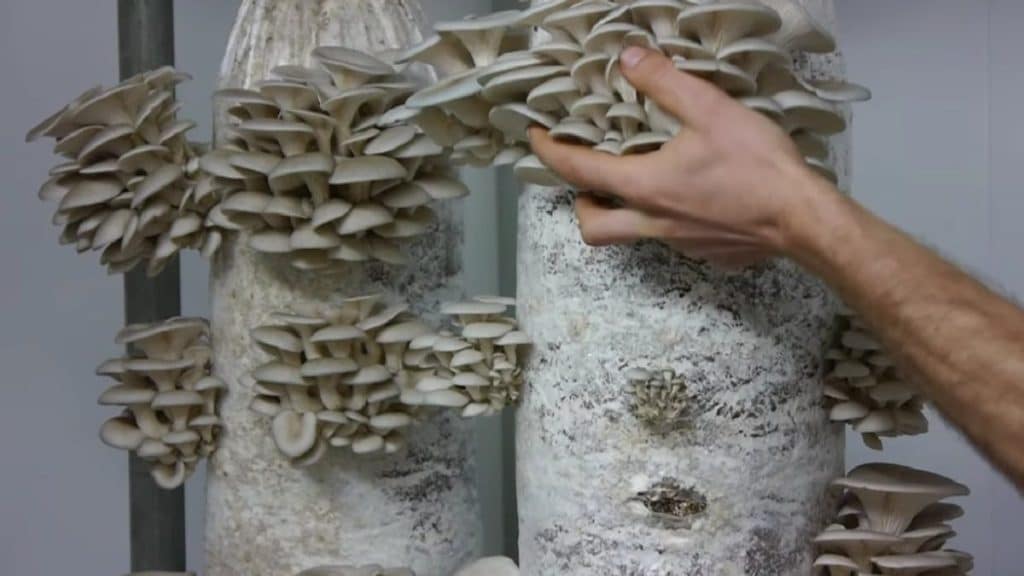
What Are Mushroom Growing Bags?
Mushroom growing bags are plastic bags specifically designed for growing mushrooms. They make the mushroom growing process much easier and often have one or more of the following features:
Gusseted
Gusseted mushroom growing bags have a pleated design with sides that fold flat when empty but expand when filled to hold a substantial amount of substrate.
When gusseted bags are filled with a substrate, they become sturdy stand-up bags with a strong, flat base.
Not all grow bags come with gussets. You also get pillow-shaped growing bags and lay flat tubing that growers use to form long substrate columns.
Filter Patch
If you see a mushroom growing bag described as a filter patch bag, it means it has a filter built into the front.
This filter allows the mushroom mycelium to breathe while preventing airborne contaminants like mold, spores or bacteria from entering the bag.
Filter patches come in various shapes and sizes, and their pore sizes range from 0.2 to 5 microns. A smaller pore size means fewer contaminants, but there is also less fresh air exchange.
Polypropylene
Polypropylene is a hardy thermoplastic with numerous applications, including mushroom-growing bags intended for use with substrates that need sterilization.
To sterilize a mushroom substrate, you need temperatures of 250°F (121°C) for an extended period.
Polypropylene growing bags can withstand high temperatures and won’t melt under temperatures of 270°F (132 °C ), making them ideal for use with nutrient-rich substrates like Master’s mix.
Autoclavable
If a growing bag is autoclavable, it’s usually made from polypropylene and can withstand the high temperatures required for sterilization inside an autoclave, sterilizer or pressure cooker.
Mushroom growing bags made for pasteurized mushroom substrates are generally made from different materials and are not autoclavable.
Injector Port
Some growing bags come with self-healing injection ports and are ideal for inoculating grain to make spawn using liquid culture.
These bags reduce the chances of contamination, and you don’t need sterile conditions for inoculation.
This is because you can inject sterile liquid culture directly into the sterilized substrate through the injection port, which immediately self-heals, protecting the substrate from contaminants.
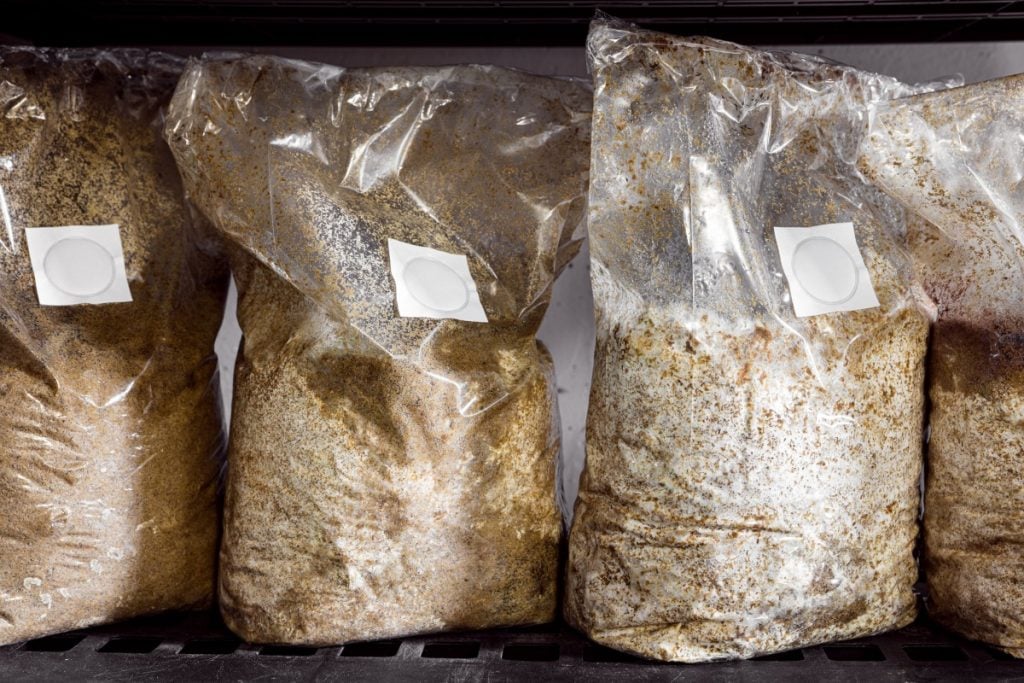
Do Mushroom Bags Need to Breathe?
Yes, mushroom grow bags do need to breathe. Like humans, fungi consume oxygen and release CO2 and need fresh air to survive.
Mushroom mycelium tolerates higher levels of CO2 during colonization, so the breathable filter patches or micro-perforations in mushroom growing bags allow sufficient air exchange.
But to initiate mushroom pinning, you’ll need to expose the mycelium to more fresh air by cutting holes in the bag or opening the top.
Can You Reuse Mushroom Grow Bags?
While you could reuse grow bags, especially if you’ve used them for top fruiting species of mushrooms, we don’t recommend it.
With repeated use, the plastic gets weaker, and multiple sterilizations can affect the filter, increasing the chances of contamination.

Why Use Mushroom Growing Bags?
One of the first decisions mushroom growers have to make is what type of containers to use, bearing in mind the functionality required.
The main functions of mushroom growing containers are to:
- Hold a given quantity of substrate
- Prevent moisture loss
- Exclude competitor organisms
- Increase the yield and quality of the mushrooms
Several containers provide this functionality. So what makes mushroom growing bags so popular, and why do so many cultivators use them?
Here are some of the benefits of growing mushrooms in bags:
Reduced Costs
Mushroom growing bags are inexpensive compared to most other containers, and even if you’re not buying them in bulk, you can find grow bags online for around $1 (£0.70) each.
Growing mushrooms in bags keeps upfront costs down, making it easier for small-scale farmers to get started and increasing profit margins.
Improved Monitoring
Clear plastic growing bags make it easy to monitor your mycelium’s growth during colonization and check for any signs of contamination.
Unlike opaque buckets and bottles, clear bags allow you to inspect your substrate from all angles, making it easier to tell when the bag is fully colonized and ready for fruiting conditions.
Versatility
You can utilize mushroom growing bags in several ways, allowing you to use them for most mushroom species.
Open the top for top-growing species like king oysters or enoki, cut holes in the sides for side-fruiting species like lion’s mane or remove the bag entirely for species like shiitake.
And, during fruiting, you can stand bags on shelves, stack them or hang them on hooks and grow mushrooms from all sides.
Bottles and jars are less versatile and only allow mushrooms to grow from the top of the container.
Easier Inoculation
Mushroom growing bags make it easier to break grain spawn into small pieces inside the bag before adding it to a bulk substrate.
And, when adding spawn directly to a bag of substrate, you can manipulate the substrate inside the bag, ensuring it’s well mixed and the spawn is evenly distributed.
Less Chance of Contamination
Producers have specially designed mushroom grow bags to reduce the chances of mushroom contamination.
They’re heat resistant, so you can sterilize a substrate inside the bag and only open them briefly in sterile conditions to introduce spawn.
Many bags also have filters that allow the mycelium to breathe while keeping moisture inside and contaminants outside.

What to Look for When Choosing Mushroom Growing Bags
There are lots of different mushroom growing bags, and knowing which to use can be confusing. Here are some things to consider when choosing a grow bag:
1. Heat Tolerance
Do you need to sterilize your substrate, or can you get away with pasteurization? If you’re sterilizing, you’ll need autoclavable bags.
If you’re pasteurizing your substrate, you can use any sturdy plastic bag with holes poked in for air exchange.
2. Filter Size
The ideal filter size depends on the species being grown and whether you plan on using the bag for spawn or substrate.
Filters with a larger pore size provide increased air exchange, but there’s a higher chance of competitor organisms getting in.
Thus, it’s best to use larger filters for faster-growing species to help reduce the chances of contamination that come with a larger filter size.
3. Bag Size
The best bag size for you will depend on the production method, as bags for substrates that need sterilization must fit inside a pressure cooker or autoclave.
Most sterile growers use 5lb (2.27kg) or 10lb (4.5kg) unicorn bags (Weight when filled with substrate). However, growers using pasteurized straw substrates often use much larger plastic bags.
When deciding what size bags to use, consider the available space and how many mushrooms you want to grow.
4. Bag Thickness
Bag thickness is another important factor, as thicker bags are less likely to tear but more expensive.
The bag thickness is fairly standard for autoclavable bags and generally ranges from 2.2 to 4 mil (56 to 100 microns). We recommend starting with the less expensive 2.2mil (56 microns) bags and taking care when handling them.
For pasteurized substrate, you need to make sure your bag is strong enough to hold the weight of the substrate. Based on our experience, 4 mil (100 micron) thick bags are suitable for up to 33 lb (15 kg) of straw substrate.

Types of Mushroom Growing Bags
There are several different types of mushroom growing bags available, and which is best to use varies depending on the mushroom species, type of substrate and quantity you plan on growing.
Below are some of the different types of mushroom bags available:
Filter Patch Bags
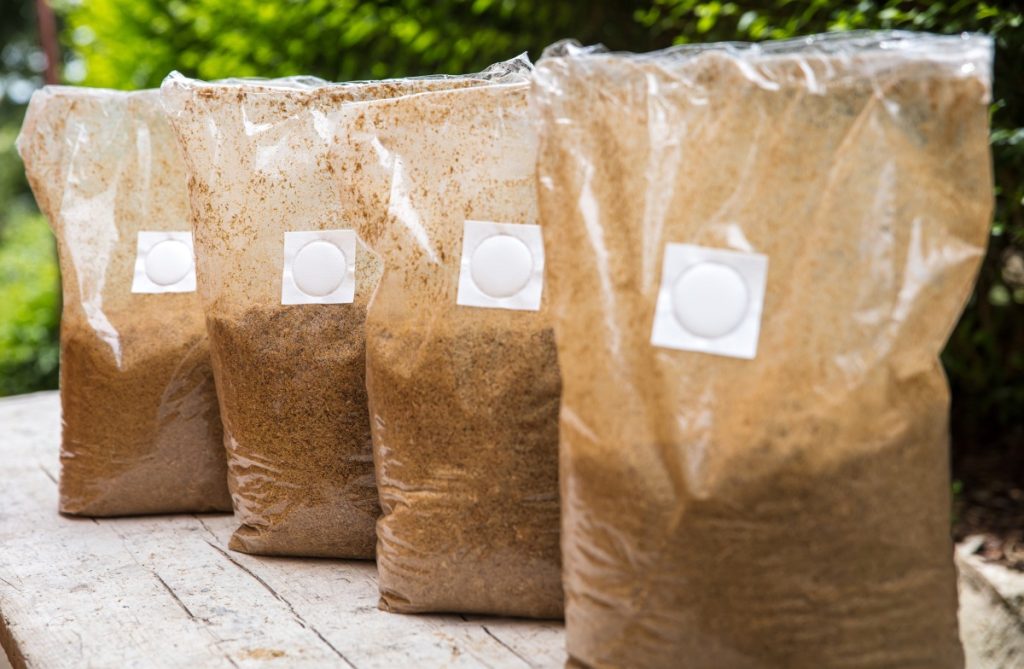
Filter patch bags are exactly what they sound like. Bags with filter patches that allow the mushroom mycelium to breathe while growing in the bag.
They come in various shapes and sizes with a range of filter pore sizes to suit all mushroom-growing techniques. Filter patch mushroom growing bags are readily available online.
Many are mass-produced in China, but one of the most popular suppliers, known for their high quality, is USA-based Unicorn Bags, whose specialty is filter patch bags.
Their filter patch bags are specifically designed for use with substrates that need sterilizing and are thus made from autoclavable polypropylene.
If you buy your bags directly from Unicorn Bags, you’ll have to buy them in boxes of 1000, but you can find smaller quantities for sale on eBay or Amazon.
Zipper Filter Bags
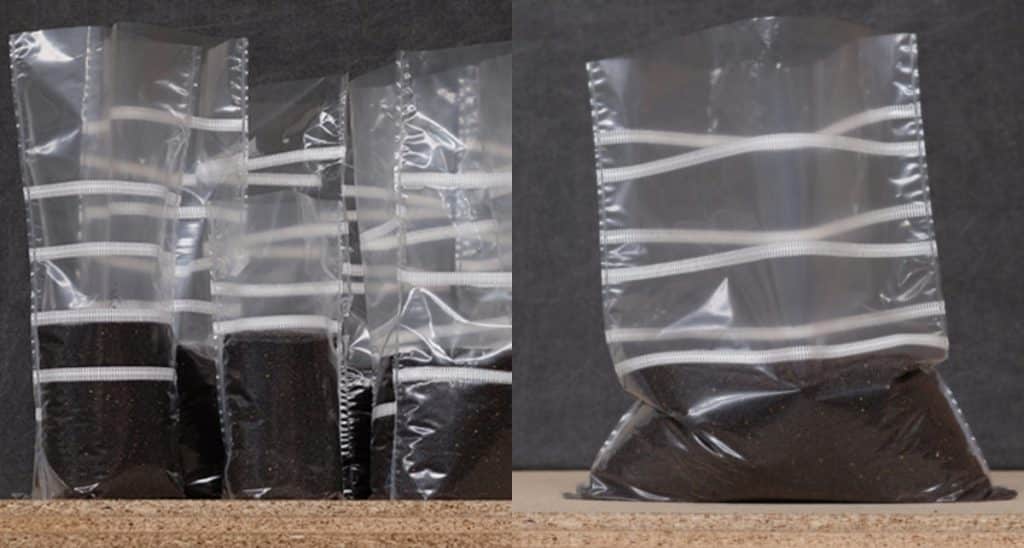
Zipper filter bags are autoclavable and have a filter to allow the mycelium to breathe, but they do not have a patch.
Instead, they have filter strips covering the whole length of the bag to optimize the fresh air exchange.
SacO2, a reputable Belgium-based company and one of the largest mushroom bag manufacturers in the world, produces these bags.
They offer different filters for spawn and substrate, and, like filter patch bags, you can choose from a range of bag and filter sizes.
The SacO2 zipper filter bags come in boxes of 500.
Layflat Tubing
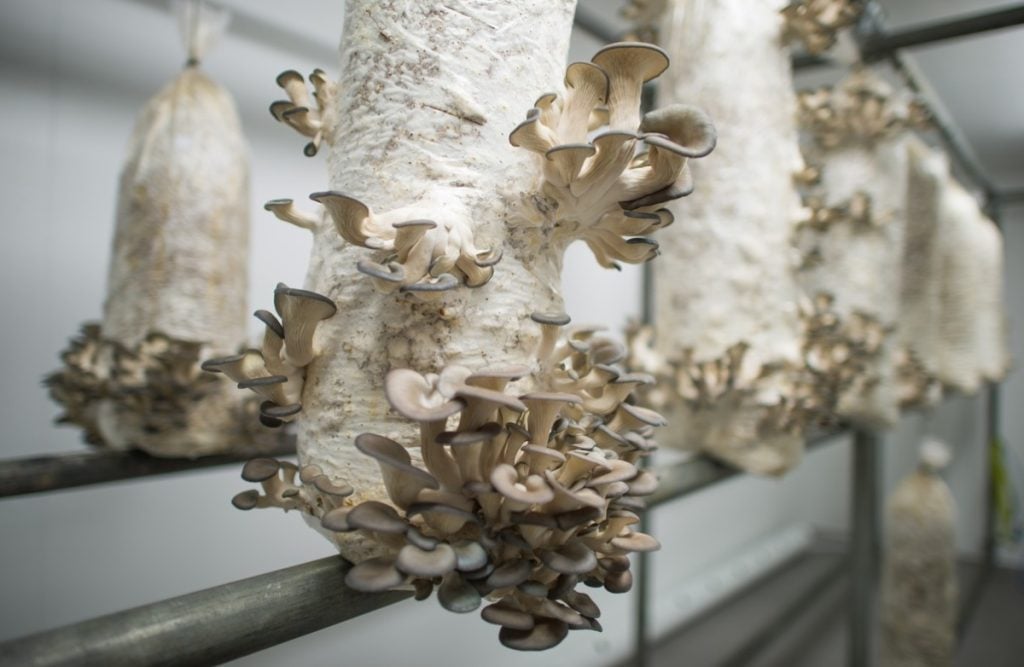
Lay flat tubing is a long, continuous plastic tube made from Polythene or Polypropylene that usually comes in a large roll.
Also known as Poly-tubing, clear poly or column bags, lay flat tubing comes in various widths and thicknesses and is a cost-effective option for pasteurized substrates.
Growers commonly use lay flat tubing to create straw substrate columns for growing oyster mushrooms.
This involves cutting a length of lay flat tubing, filling it with pasteurized straw substrate, tying the ends shut and poking holes in the bag for the mycelium to breathe.
Large Gusseted Plastic Bags
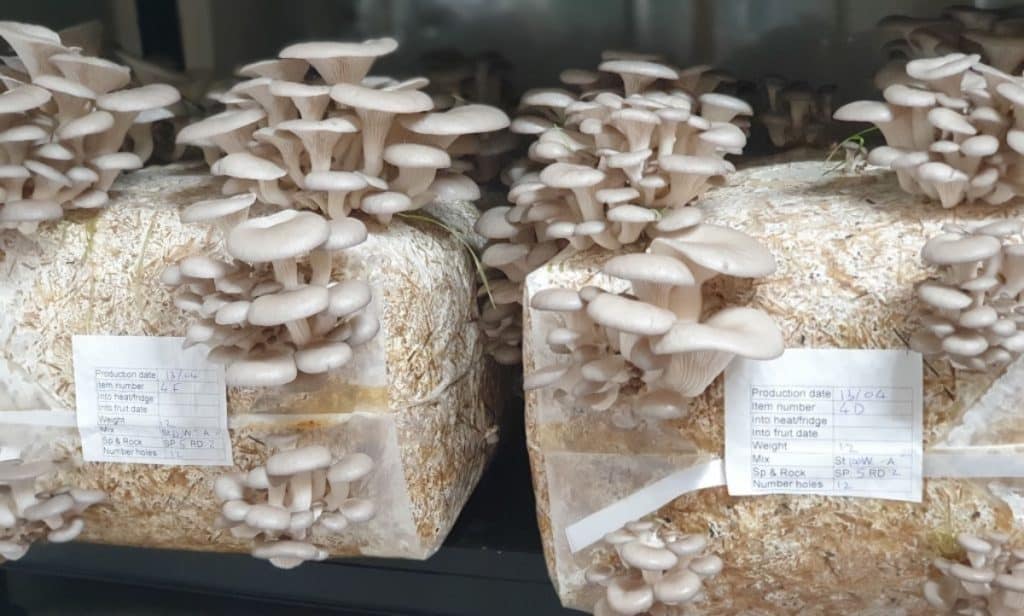
Mushroom growers use larger gusseted plastic bags that hold 26 to 44 pounds (12 to 20 kg) of substrate to make oyster bales with pasteurized substrates like straw or sugarcane bagasse.
This method of growing oyster mushrooms is popular throughout Europe and helps to reduce plastic waste, as you use fewer bags to hold the same amount of substrate.
The material used for these bags is polyethylene, and they’re not autoclavable and don’t have breathable filter patches.
Because you don’t need autoclavable bags to make pasteurized substrate bales, it opens up the possibility of using biodegradable bags, making the process more eco-friendly.
To learn more about our experiments growing mushrooms using biodegradable bags, have a look at the video below.
Smaller Cylindrical Bags
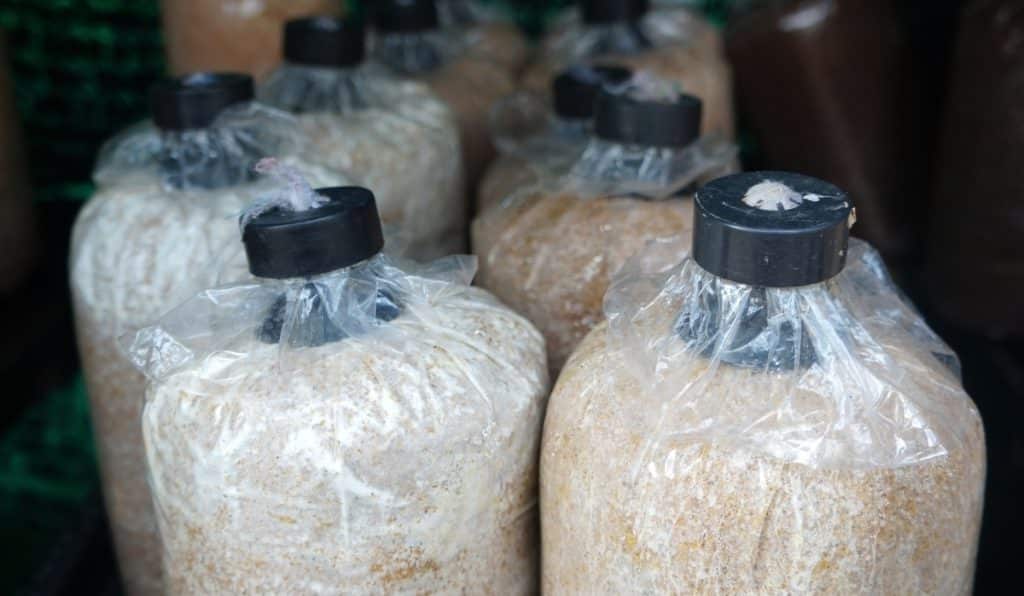
Many Asian mushroom farmers use inexpensive, cylindrical polyethylene bags without filters, usually 6 to 7 inches (15 to 17 cm) wide and about 12 inches (30 cm) long.
Instead of a filter, they use a collar and cotton plug for air exchange.
For this method, growers fill 3/4 of the bag with the substrate, fold the top over and sterilize the substrate.
After sterilization, they open the top of the bag in a glove box, inoculate with spawn or culture, and insert the collar and cotton plug into the top.
DIY Mushroom Growing Bags
You won’t need heat-resistant bags if you’re cultivating easy-to-grow mushrooms like oyster mushrooms that thrive on less nutritious substrates.
An easy way for beginners to try growing mushrooms without buying a pack of mushroom grow bags is to use large ziplock freezer bags.
You can find these at your local grocery store, and some of the larger bags are 2 mils (50 microns) thick, making them less likely to split.
Don’t forget your mushroom mycelium needs to breathe.
You can make a breathable filter in the freezer bag by cutting a 0.8-inch (2cm) hole and filling it with Polyfill. Or punch some smaller holes in the bag and cover them with micropore tape.
Alternatives to Mushroom Growing Bags
Although mushroom growing bags are the most widely used containers, they’re not the only way to grow mushrooms. You can use several other types of containers, including buckets, bottles, jars, totes, trays and more.
Which container is best for mushroom growing?
The best container will vary depending on the type of mushrooms you want to grow, the conditions they need, the available space and your budget.
In the video below, we look at some of the pros and cons of growing mushrooms using bags, bottles and bales.
Final Thoughts
Mushroom growing bags are specially designed to make mushroom farmers’ lives easier by reducing the chances of contamination and providing conditions that increase yields.
A real downside to growing mushrooms in bags is the plastic waste created. Reusable bottles are more environmentally friendly, but cleaning them between crops can be extremely time-consuming.
Fortunately, some gourmet mushroom species grow well on pasteurized substrates, providing opportunities to explore alternative containers like buckets or 100% compostable bags that create less plastic waste.
To learn more about growing mushrooms the low-tech way, visit our Mushroom Growing Hub or sign up for one of our mushroom cultivation courses.
